The Toshiba TR200 is a budget-friendly drive that features both low power consumption during operation and cost savings. The TR200 Series is the company’s first consumer SSD equipped with 64-Layer 3-bit-per-cell TLC BiCS FLASH, technology that previously only shipped with OEM products. Though Toshiba has indicated that their retail SSDs will now be branded under their name (while OCZ will act as a sub-series), they will have the same performance of OCZ drives and will still target the same markets.
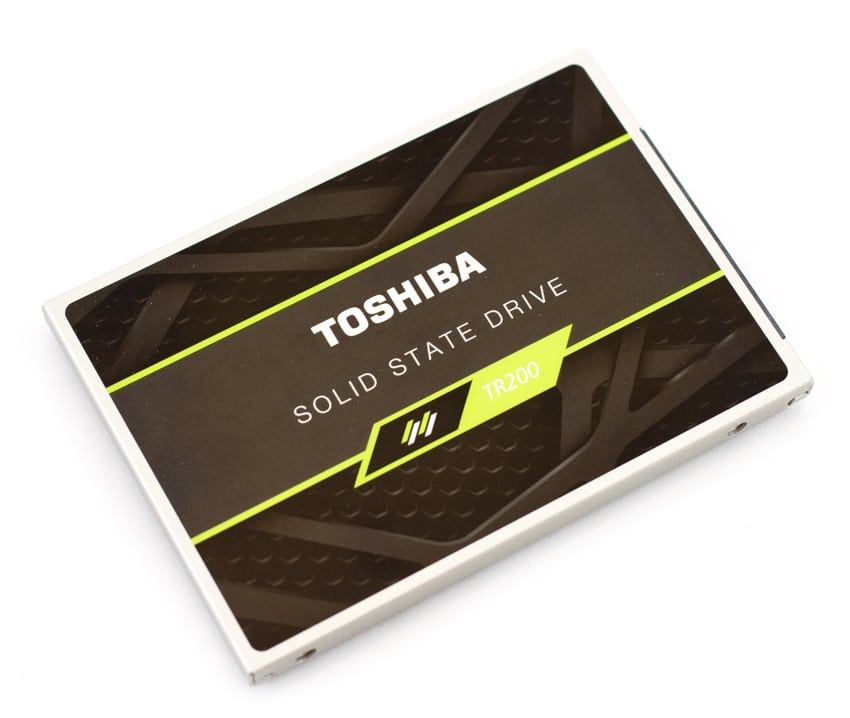
Like all entry-level SSDs in the storage industry, the TR200 is targeted to first-time SSD adopters (e.g. those looking to upgrade their HDD-based system to solid-state technology). Even though it’s just a budget drive, users will certainly see a significant, overall increase in performance in both notebooks and desktops (boot times, application load times, etc.). To this end, Toshiba quotes sequential performance of 550MB/s read and 525MB/s write, while random performance is expected to hit 80K IOPS read and 87K IOPS write. Toshiba adds that their BiCSFLASH technology also offers higher capacity (due to its stacked cell structure), higher endurance (with its charge trap cell and memory hole technology), and better performance (using its 1-shot program called “full sequence”).
Backed by a 3-year warranty, the Toshiba TR200 is available in capacities of 240GB ($89.99), 480GB ($149.99) and 960GB ($289.99).
Toshiba TR200 Specifications
- Interface: SATA 6Gbit/s
- Form Factor: 2.5-inch
- Flash Components: 64-layer 3D BiCSTLC
- Capacities: 240GB –960GB
- Performance
- Sequential Read: Up to 550 MB/s
- Sequential Write: Up to 525 MB/s
- Random Read: Up to 80,000 KiB IOPS
- Random Write: Up to 87,000 KiB IOPS
- Endurance: 60~ 240 TBW
- DEVSLP (max.): Up to 10 mW
- Active Power: 1.6 W (960GB model)
- Encryption: None
- Endurance: 240 TBW (960GB model)
- MTTF/MTBF: 1.5 Mh
- Warranty: 3Years
Design and Build
With its green, white and black design, Toshiba has gone in a completely new direction compared to the traditional white, blue and black OCZ color scheme. This slick-looking SSD uses the same 2.5”, 7mm z-height form factor aluminum case.
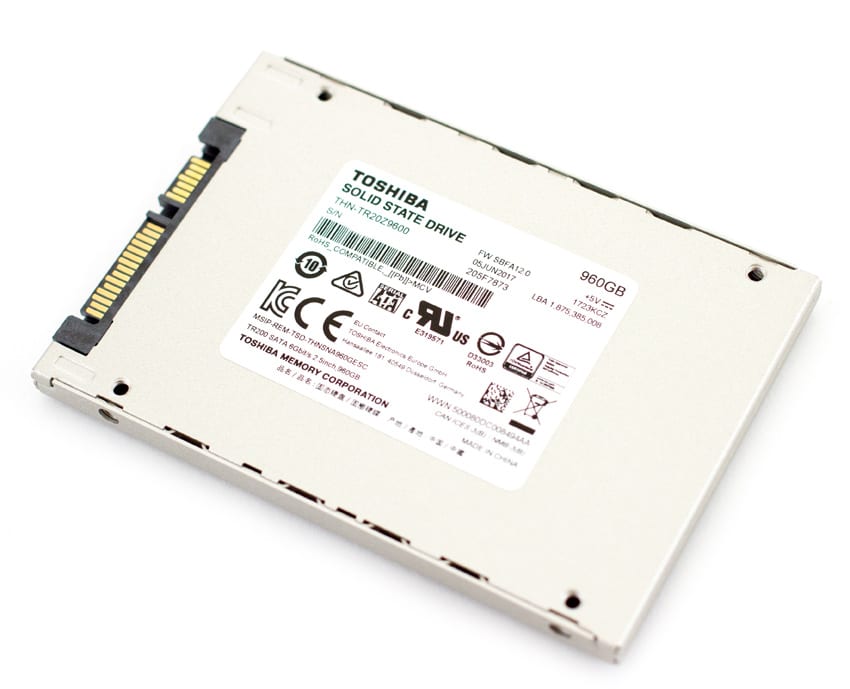
Turning the drive over shows the usual sticker that displays further information about the drive, such as capacity and model number.
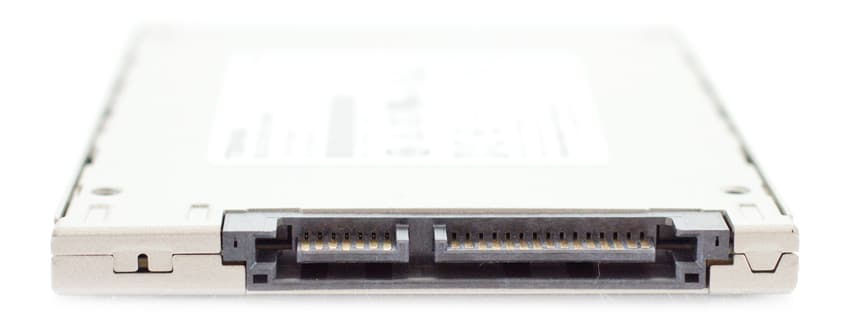
Opening the drive up is easy and straightforward: simply prop the two parts of the case apart, which is held together by tabs. Once inside, you’ll notice Toshiba NAND packs on the top of the PCB as well as a Toshiba controller.
On the other side of the PCB board are more NAND packs.
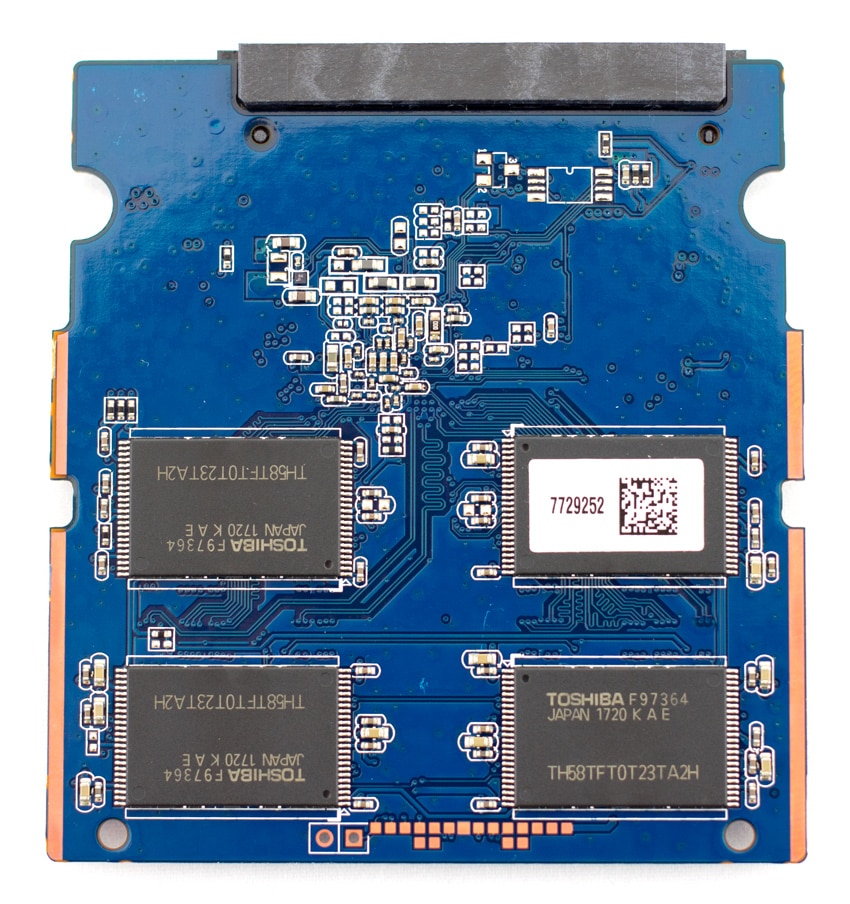
Management
The OCZ SSD Utility is a free management software that provides users with an easy way to maintain, monitor and optimize OCZ SSDs such as updating firmware and enabling settings to promote long-term performance.
The software’s dashboard gives an at-a-glance, real-time overview of things like system status, capacity, interface, updates and health. You will also be able to monitor the drive temperature from this section.
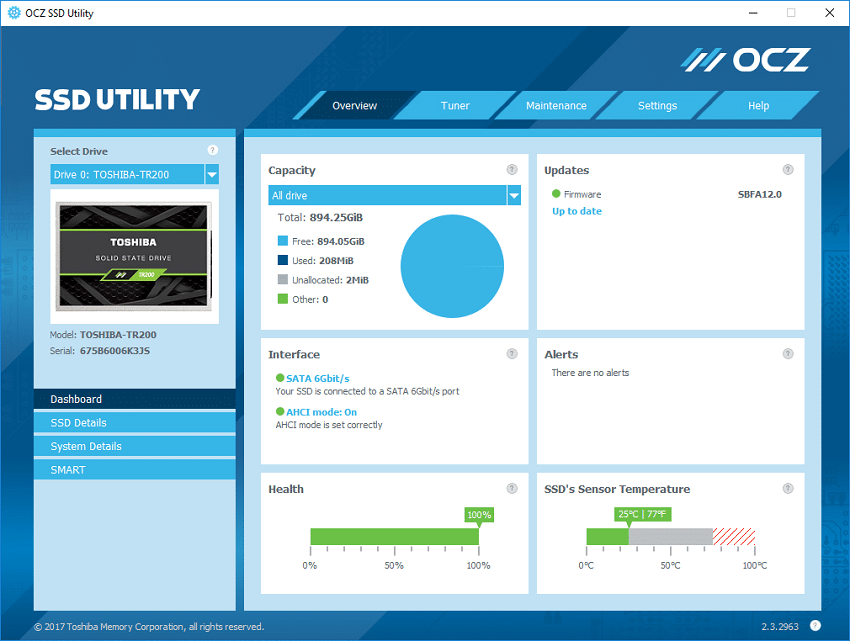
As it indicates below, the Tuner section allows users to put their TR200 SSD through a series of quick benchmark tests to get an idea of random, sequential and average latency performance of the drive.
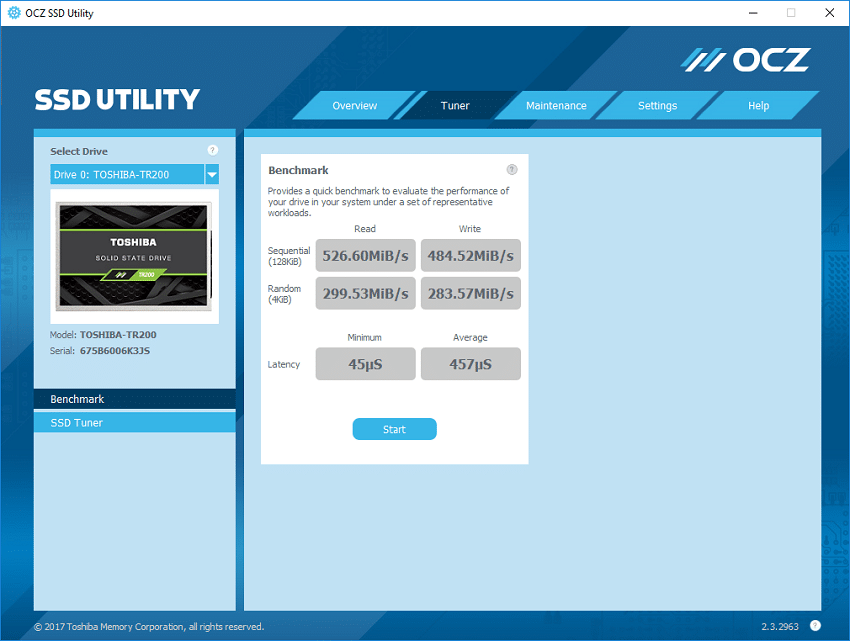
Consumer Synthetic Benchmarks
All consumer SSD benchmarks are conducted with the StorageReview HP Z640 Workstation. We compared the Toshiba TR200 to the following drives:
- Samsung 850 EVO 1TB
- Samsung 850 EVO 2TB
- Micron M600 1TB
- Sandisk Extreme Pro 1TB
- Crucial MX200 500GB
- Crucial MX200 500GB
- Samsung 850 Pro SSD (2TB)
- OCZ VX500 SSD (512GB)
- ADATA SU900 SSD (512GB)
- SanDisk Ultra 3D (1TB)
- Crucial BX300 480GB
All IOMeter figures are represented as binary figures for MB/s speeds.
Looking at 2MB sequential performance, the TR200 was at the bottom of the pack with 449.86MB/s read and 448.55MB/s write, which was roughly 50MB/s slower than the next best drive in reads.
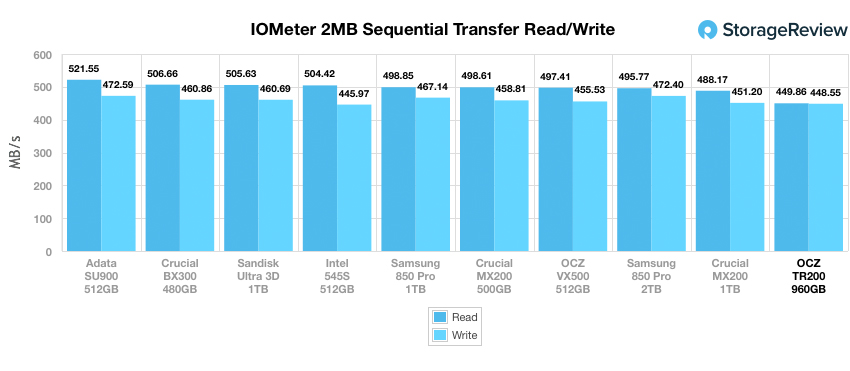
2MB random transfer performance was more of the same, as the TR200 posted just 399.27MB/s read and 383.51MB/s.
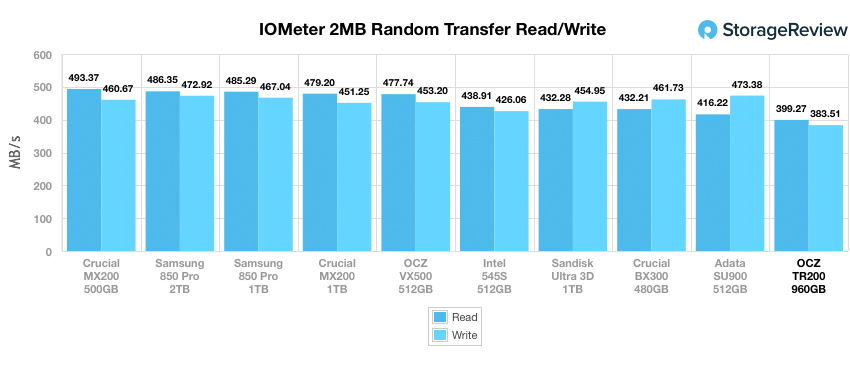
The TR200 performed better in read activity when switching to smaller 4K random transfers with 32.05MB/s read, which placed it in the middle of the pack. Write performance, however, were much further back with 76.89MB/s.
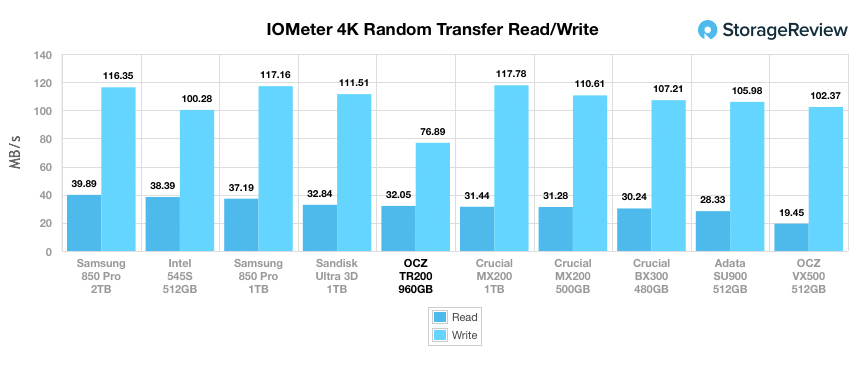
In IOPS, the TR200 again performed fairly well for its class in the read category with 8,205.0 IOPS. That said, write performance followed the same trend as earlier, remaining far behind the other tested consumer SSDs with 19,684.92 IOPS.
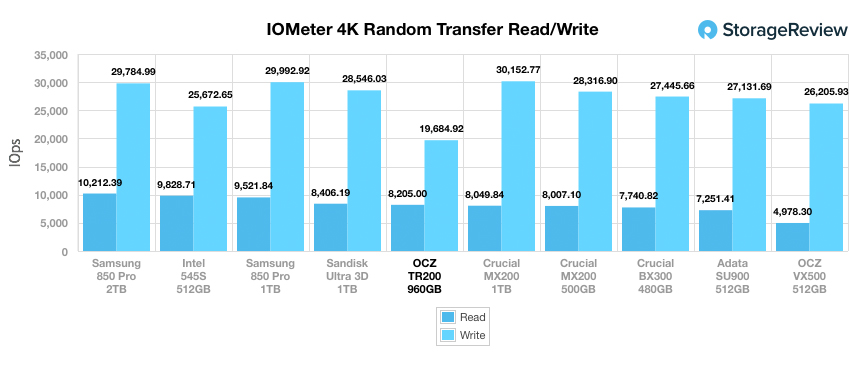
Our 4K write latency benchmark looks at both the average and maximum readings. Here, the TR200 showed its budget-SSD performance with 0.0506ms and 528.764ms in average and maximum latency, respectively.
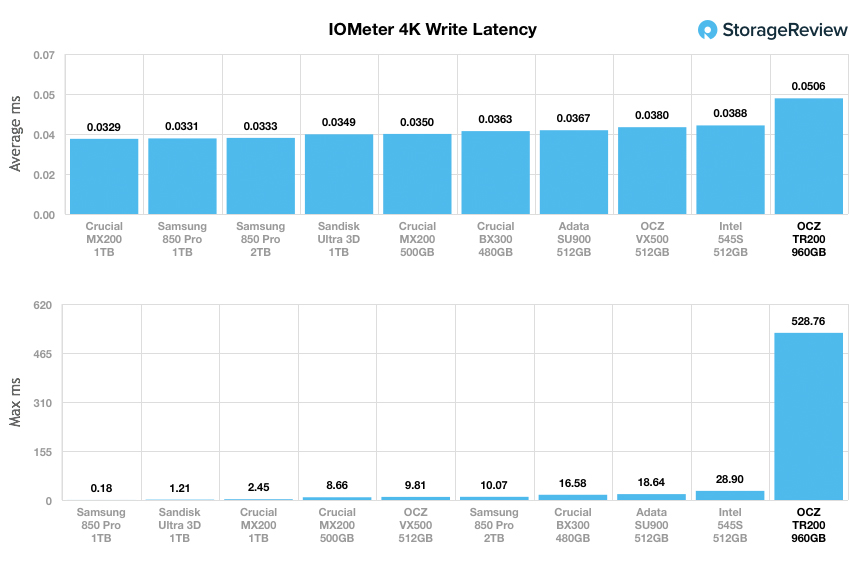
Our next test shifts to a 4k random workload with 100% read activity that scales from 1QD to 64QD. In this scenario, the TR200 measured 22,804.86 IOPS through 42,827.78 IOPS, which was half the performance of the higher-end SSD comparables.
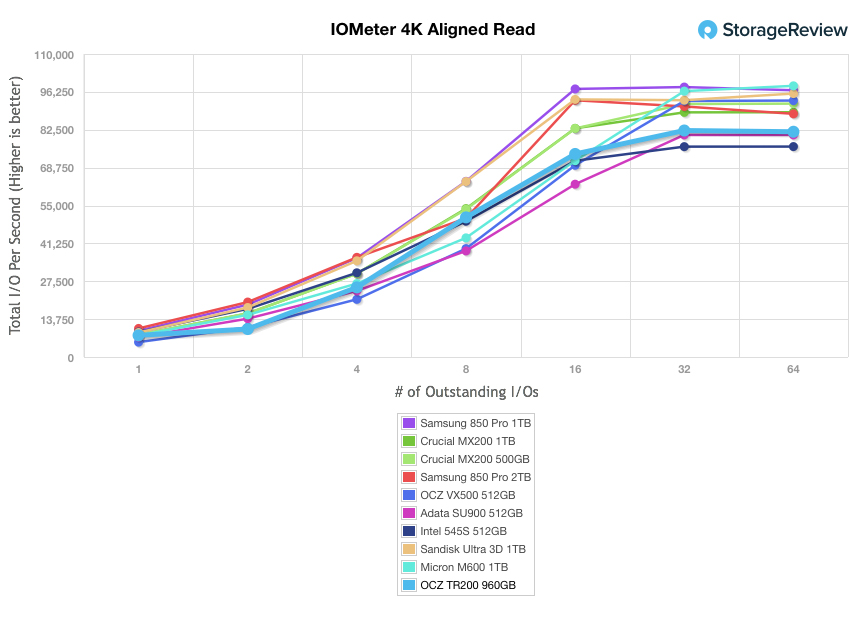
In write activity of the same benchmark, the TR200 posted much better results with a range of 7,868.57 IOPS to 81,774.38381 IOPS, placing it just above the Intel and ADATA drives.
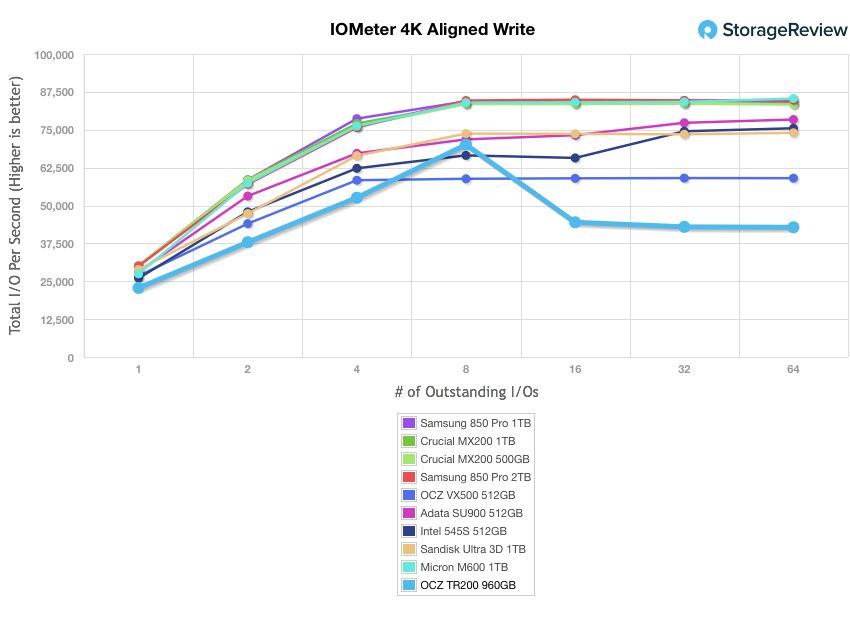
Our last series of synthetic benchmarks compare the SSDs in a series of server mixed-workloads with a queue depth of ranging from 1 to 128. Each of our server profile tests has a strong preference towards read activity, ranging from 67% read with our database profile to 100% read in our web server profile.
The first is our database profile, which consists of a 67% read and 33% write workload mix primarily centered on 8K transfer sizes. Here, the TR200 measured a range of 5,937.75 IOPS to 28,238.05 IOPS, placing it just above the ADATA SSD.
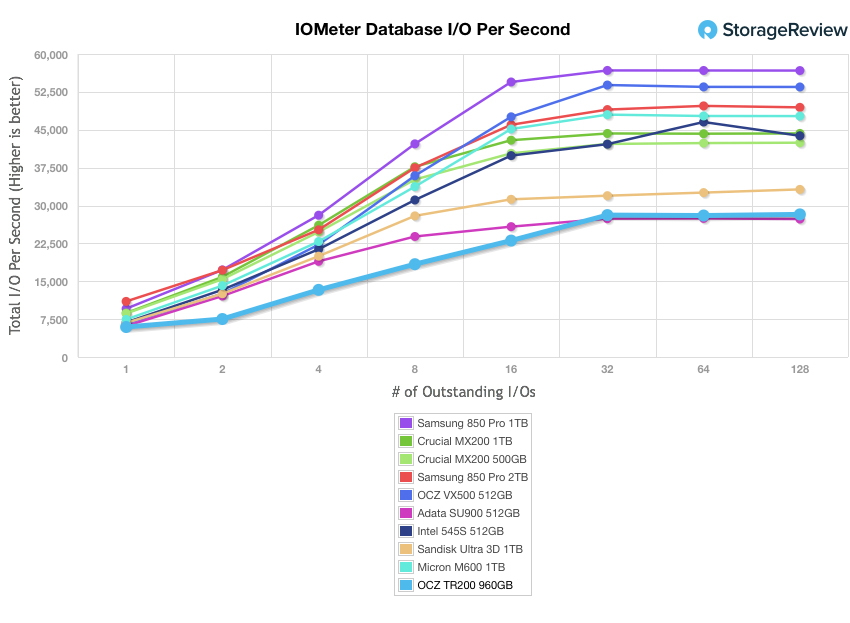
Our web server profile is read-only with a spread of transfer sizes from 512-byte to 512KB. In this workload, the TR200 offered a range of 5,098.79 IOPS to 18,964.20 IOPS.
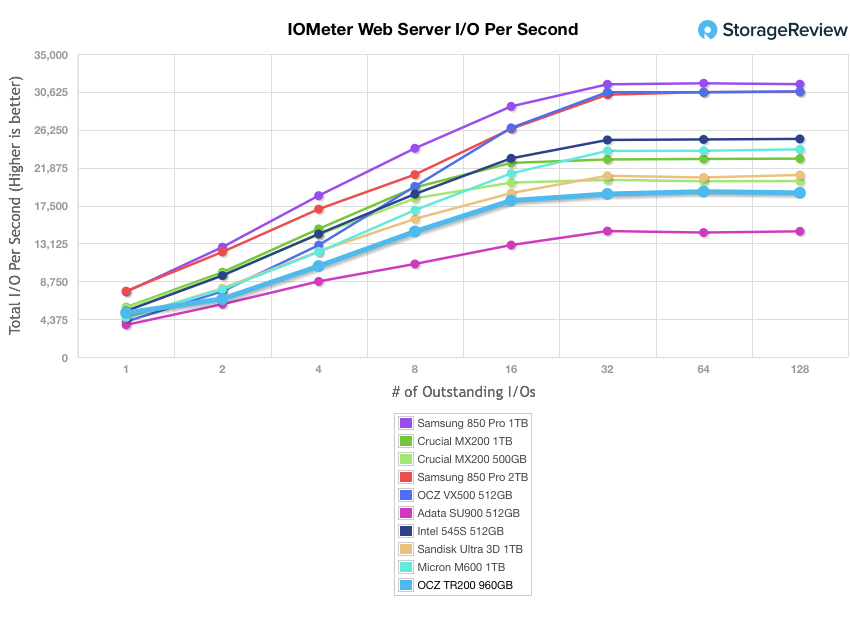
The next profile looks at a file server, with 80% read and 20% write workload spread out over multiple transfer sizes ranging from 512-byte to 64KB. The TR200 delivered a decent burst speed of 5,082.42 IOPS; however, it only managed to record 21,882.473 IOPS by the end.
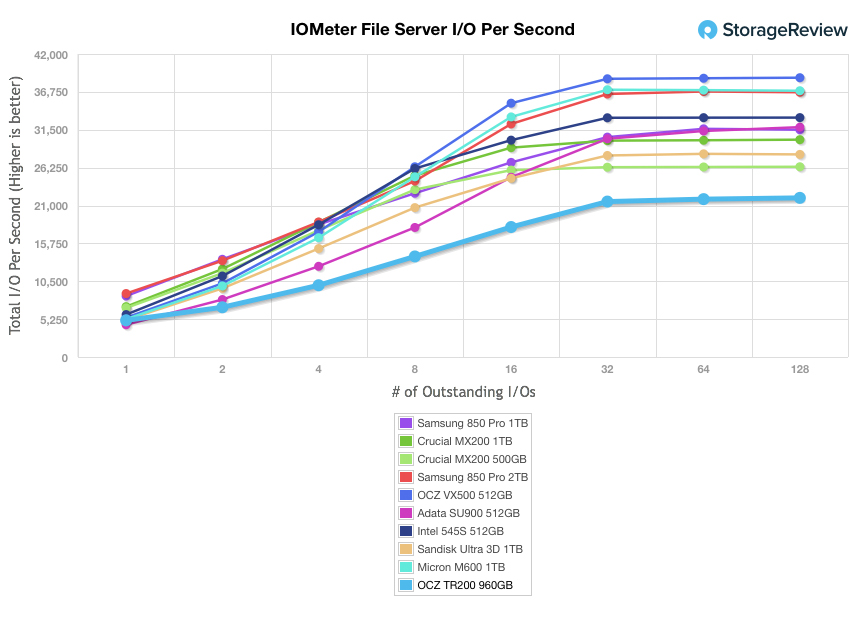
The last profile looks at workstation activity, with a 20% write and 80% read mixture using 8K transfers. Again, the TR200 had a strong start at 6,940.28 IOPS; however, it ended up placing at the bottom of the pack with 22,130.84 IOPS.
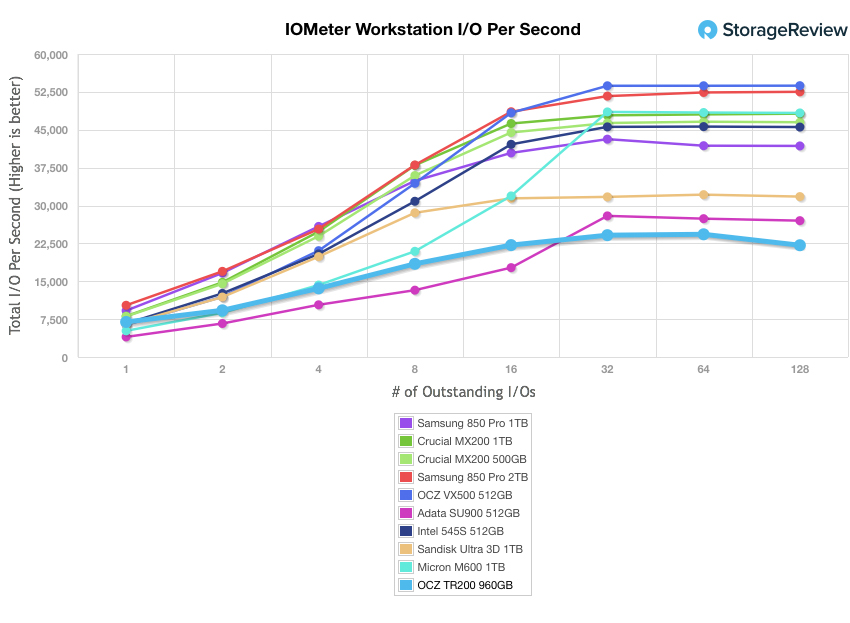
Consumer Real-World Benchmarks
While the results of synthetic benchmarks are important in identifying the key strengths and weaknesses of a drive, performance in these tests does not always translate directly into real-world situations. To get a better idea how the Toshiba TR200 drive will handle itself in the field, we will chart StorageMark 2010 HTPC, Productivity, and Gaming traces against comparable drives. Higher IOPS and MB/s rates with lower latency times are preferred.
The first trace is based on use as a Home Theater PC (HTPC). The test includes playing one 720P HD movie in Media Player Classic, one 480P SD movie playing in VLC, three movies downloading simultaneously through iTunes, and one 1080i HDTV stream being recorded through Windows Media Center over a 15-minute period.
In our HTPC trace, the TR200 was able to hit 5,702.16 IOPS, 260.34MB/s and an average latency of 1.331ms, placing it in the lower- to mid-range part of the leaderboard.
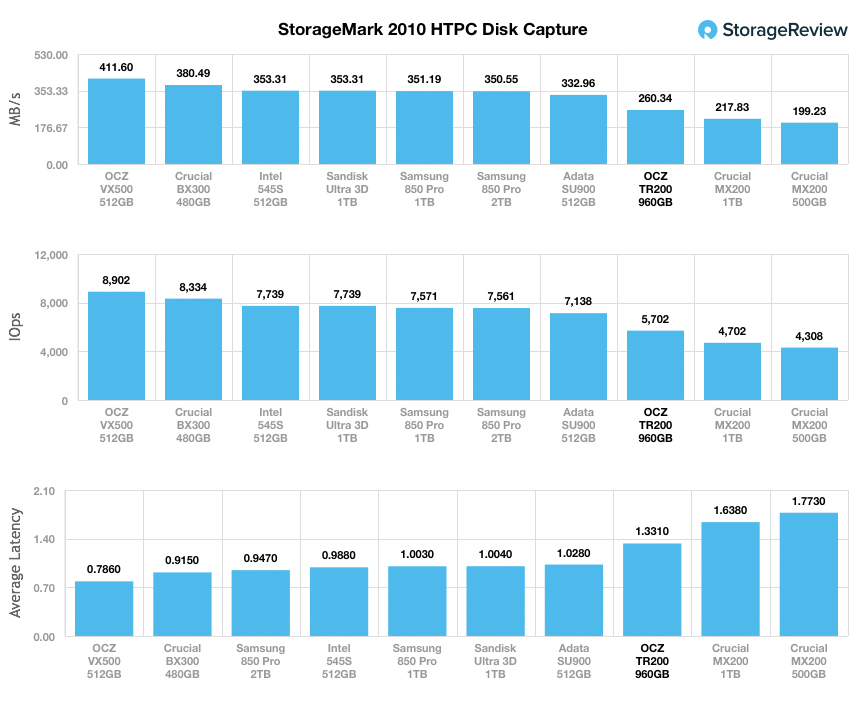
The next trace simulates disk activity in an office workstation or productivity scenario. This test includes three hours of operation in an office productivity environment with 32-bit Windows Vista running Outlook 2007 connected to an Exchange server, web browsing using Chrome and IE8, editing files within Office 2007, viewing PDFs in Adobe Reader, an hour of local music playback, and two hours of streaming music via Pandora.
With our productivity trace, the TR200 remained in the mid to lower range, with 4,744.24 IOPS, 140.53MBés and an average latency of 1.628ms.
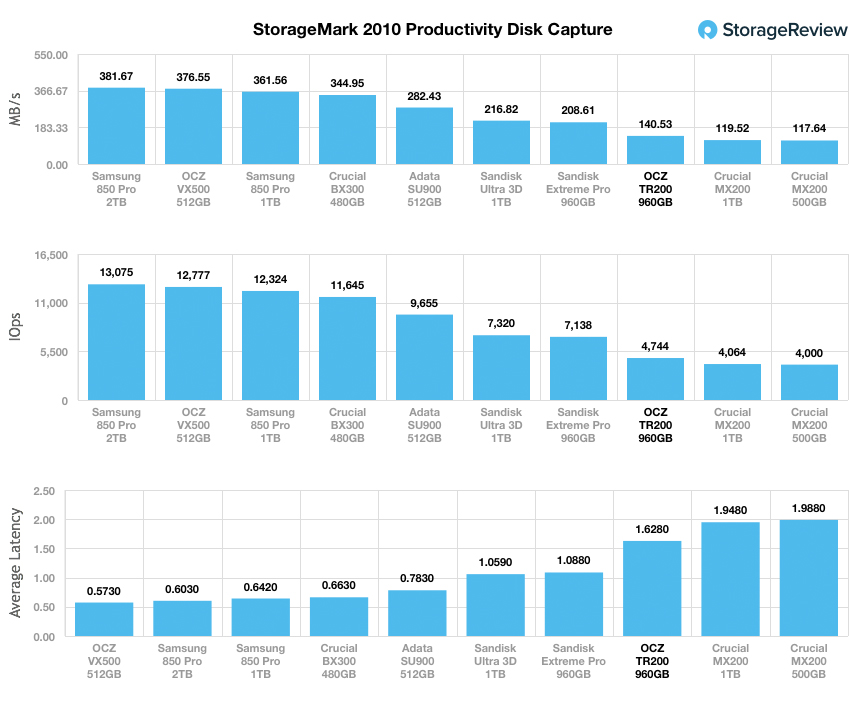
The final consumer real-life benchmark simulates disk activity during gaming. This simulation taxes the drive’s read performance, with 6% write operations and 94% read operations. The test consists of a Windows 7 Ultimate 64-bit system pre-configured with Steam, and with Grand Theft Auto 4, Left 4 Dead 2, and Mass Effect 2 already downloaded and installed. The trace captures the heavy read activity of each game loading from the start, as well as textures as the game progresses.
In our gaming benchmark, the TR200 fell to the bottom of the pack again with 7,218.1 IOPS, 388.48MB/s and 1.082 in average latency.
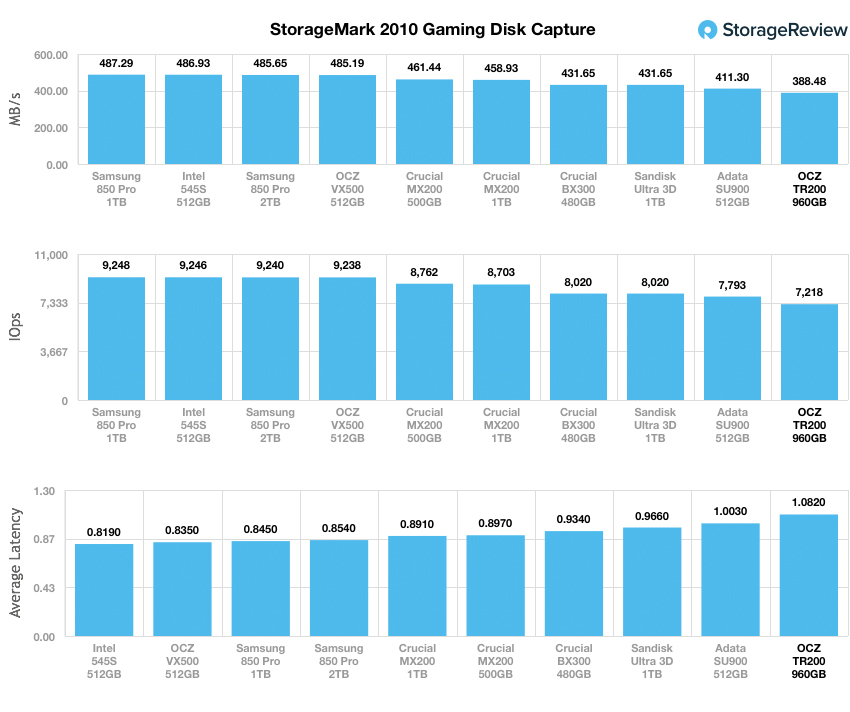
Conclusion
The Toshiba TR200 is the company’s newest budget line of SSDs designed for consumers looking to upgrade their HDD-based rig to solid-state technology. The Toshiba drive features 64-Layer 3-bit-per-cell TLC BiCS FLASH NAND, an in-house Toshiba controller and a 7mm-to-9.5mm adapter bracket. Because it uses the normal 2.5″ (7mm) form factor and SATA 6Gb/s interface, the TR200 can fit inside most any computer: from compact desktop PCs, to ultra-slim notebooks.
Even though the TR200 caters solely towards value-oriented consumers with one of the most affordable price tags we’ve seen, we were still disappointed in the overall performance of Toshiba’s new drive. This wasn’t surprising, however, as its predecessor (the TL100) recorded similar sub-par results. For example, in sequential 2MB workloads, the TR200 showed 449.86MB/s read and 448.55MB/s write, placing it well behind the leaders and 50MB/s slower than the next best budget drive in read activity. In our random workload, the TR200 drive showed read and write transfer speeds of just 399.27MB/s and 383.51MB/s, respectively. Results were more of the same during our smaller 4k random transfers and latency benchmarks. During our server profile tests, as it placed near or at the bottom of the pack among the other tested SSDs. Moving to our real-world workloads, the new Toshiba drive model showed slightly better performance during our Productivity and HTPC traces (placing in the mid to lower range), though it ranked at the very bottom in our Gaming profile test.
Regardless of this sub-par performance, the TR200 will certainly offer significantly faster boot-ups and overall responsiveness compared to platter-based systems. Toshiba stresses this fact. However, other budget drives like BX300 outperformed the TR200 in every category–sometimes by a significant margin–all the while featuring an identical price tag. This puts the new Toshiba drive in a tough spot, as it is difficult to recommend as a result. Because the budget SSD market is filled with so many viable options, drives of this class really need to stand out in some way. And though the TR200 does offer better power efficiency than most (i.e. an average of 1.6W during operation activity for the 960GB model), we’re just not sure that’s enough to warrant a purchase until this drive is priced more aggressively than its competitors.
Pros
- Low power consumption
- Inexpensive
Cons
- Poor overall performance in budget SSD class
The Bottom Line
Though the Toshiba TR200 is one of the more cost-effective HDD replacement drives on the market, the new budget SSD was outperformed by drives from its own class. The TR200 is a fine entry SSD for most however when priced below competitive offerings.


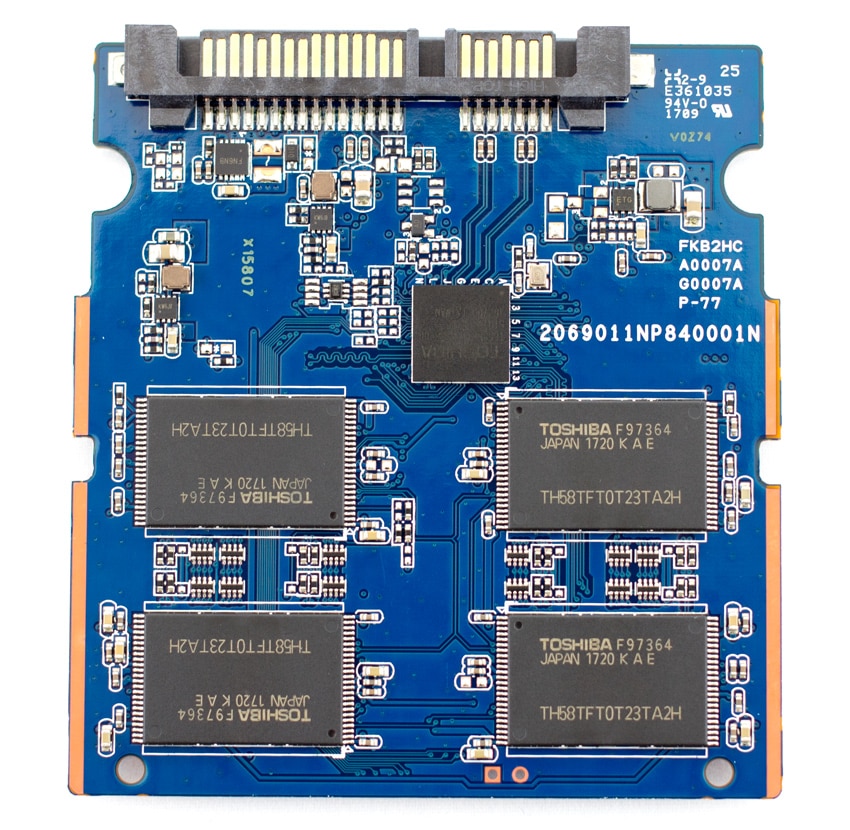


 Amazon
Amazon